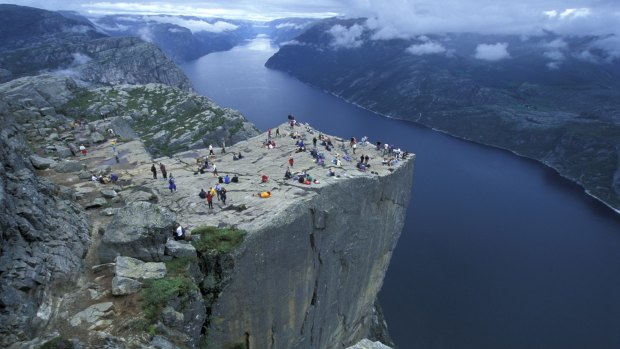This was published 4 years ago
Norway's Stavanger is an oil-rich city with fine dining, hiking and amazing fiords

Pulpit Rock.Credit: Casper Tybjerg
The Norwegian city of Stavanger is the glittering gateway to Norway's riches. It won a multibillion-dollar oil lottery and the country invested wisely in its rivers of undersea black gold.
Once, in the 1950s, it was all about fish. Back then Stavanger was Norway's "canned capital" with more than 50 canneries. The last one closed in 2002 because Stavanger had bigger fish to fry and more importantly, they had the oil to do it. The 1969 discovery of the Ekofisk oil fields 320 kilometres south-west of Stavanger in the North Sea changed the fortunes not just of Stavanger but also of Norway.
The World Bank ranks Norway among the world's richest countries – 496 times richer than the world's poorest, Burundi. It's thanks to North Sea oil and gas but also to the way Norway has handled the windfall. It resisted privatisation and instead invested billions in the Norwegian Government Pension Fund Global. Nearly $US1 trillion has been provided for future generations for when the oil runs out. Some point out that extracting oil hardly benefits the environment, and that Norway emphasises green energy – hydropower meets about 95 per cent of Norway's energy needs – but exports pollution. Whatever your opinion, Stavanger was the early gateway town for the oil rush.
Hemmed in by glittering fiords, mountains and white beaches, the city's sobriquet – Europe's oil and energy capital – was enhanced when Norway's national (and largest) oil company, Equinor, established headquarters there. Other huge state-owned petroleum-involved companies followed suit, as did international oil companies. NATO's Joint Warfare Centre is also in Stavanger.
The upshot is that since 2000 Stavanger has consistently had an unemployment rate lower than the Norwegian and European averages and welcomes diverse nationalities. Andrea, our Norwegian-speaking Kiwi guide (formerly of Auckland) is a case in point. Her partner's work in the industry drew her to Stavanger, which she loves. Andrea tells us there are more than 175 different nationalities in Stavanger, now Norway's third-largest city after Oslo, Bergen and Trondheim.
Stavanger's Norwegian Petroleum Museum gives insight into the oil industry with display items that include submersibles, a large drill bit and an escape chute. With all that industry, the city could be an ugly duckling but it's not all about the oil. Old Stavanger has Europe's best-preserved wooden house settlement with 173 lovely white 18th and 19th century dwellings. A high regard for heritage has protected the city and it retains a charming, small-town character. Meanwhile, greater Stavanger accommodates the city sprawl.
Old Stavanger is not a museum – people live here and the area has numerous galleries and handicraft boutiques, as well as the Norwegian Canning Museum and Stavanger Maritime Museum. A former European capital of culture, it is dynamic with an engaging cultural scene. It became the first Norwegian city, outside Oslo, to earn a Michelin star in 2016 with the inclusion of its restaurant Re-Naa. Owner and chef Sven Erik Renaa tells the story and history of the region through his food. He uses ingredients from within 30 minutes of his restaurant – game, mushrooms, seafood (including traditional smoked herring) and salt-infused lamb that graze on seaside meadows. It's "Stavanger on a plate". The herring was once exported to the world from the canning factories and the fish-canning museum expands on this history.
The city, on the Stavanger Peninsula, population 130,000, was officially founded in 1125, when the Stavanger Cathedral was completed. It's one of Norway's oldest cities, though its history fades even further into time – first traces of settlement date to the retreat of the last ice age about 10,000 years ago. It was an economic and military centre in the 9th and 10th centuries after the great Viking naval Battle of Hafrsfjord in about 872.
Ringed by fiords and mountains, it is at the centre of what Norwegians love to do best – active stuff. We are fortunate to experience one of Norway's most popular hikes up nearby Preikestolen (Pulpit Rock) in the Lysefjord. About 300,000 people climb to the top each year to survey the vertiginous 604-metre drop to the fiord below. Colossal, light-coloured mountains crowd the fiord, some reaching to more than 1000 metres. Green valleys and plains interlace with lakes and down below is our toy-like expedition ship. You can sit on the edge of the rock but it is inadvisable to hang off the sheer cliff face as Tom Cruise did in Mission Impossible:Fallout.
Stavanger is an interesting example of Norway's vexed nexus between oil extraction and natural wonderland. If oil is not your thing, there's nature in spades.
TRIP NOTES
Alison Stewart travelled as a guest of APT.
MORE
FLY
Qatar Airways flies daily from Sydney and Melbourne to Stockholm or Oslo via Doha, then Tromso with Scandinavian Airlines. See qatarairways.com; flysas.com/au-en/
CRUISE
APT's 15-day Majestic Norwegian Fjords cruise from Tromso to Copenhagen starts from $17,495 a person, twin share with an air credit saving of $1200 a couple, based on a June 18, 2020 departure. See aptouring.com.au
Sign up for the Traveller Deals newsletter
Get exclusive travel deals delivered straight to your inbox. Sign up now.